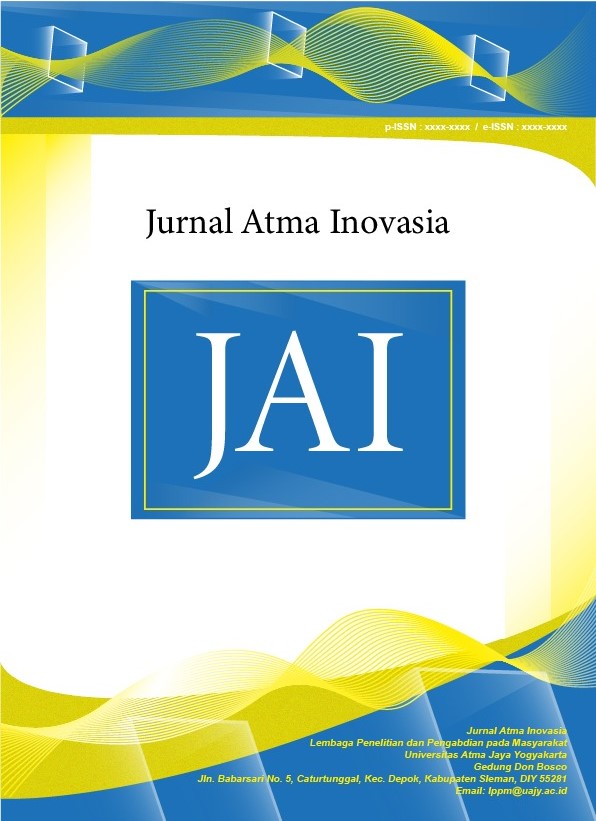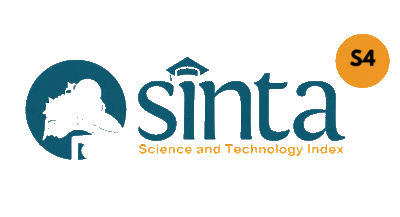Pemetaan Aset Wisata Berbasis Partisipasi di Kelurahan Cokrodiningratan, Kecamatan Jetis, Kota Yogyakarta
DOI:
https://doi.org/10.24002/jai.v4i4.9432Abstract
Kegiatan pengabdian pada masyarakat ini diusulkan untuk menjawab permasalahan akan minimnya proses pelibatan masyarakat dalam perencanaan kepariwisataan dan merespon harapan warga dan para penggerak pariwisata di bantaran Kali Code akan pendampingan akademisi terhadap upaya lokal dalam memetakan aset wisata. Berlokasi di Kelurahan Cokrodiningratan, Kecamatan Jetis, Yogyakarta, pemetaan aset wisata berbasis partisipasi dilaksanakan oleh Tim Pengabdian pada Masyarakat Departemen Arsitektur FT UAJY dengan melibatkan mahasiswa peserta Kerja Praktik sebagai fasilitator dan dengan menggunakan metode Focus Group Discussion dan teknologi digital. Tujuan dari pemetaan aset wisata adalah memberikan dasar bagi penyusunan masterplan kepariwisataan Kelurahan Cokrodiningratan berupa data jenis aset wisata yang dinilai vital oleh warga dan peta sebaran aset wisata melalui perencanaan berbasis partisipasi. Kegiatan ini melibatkan 6 mahasiswa dan 13 warga yang berasal dari RW V-XI dan berhasil menjaring sedikitnya 94 aset wisata yang dinilai vital sebagai atraksi wisata unggulan.
Kata Kunci—pemetaan aset wisata, potensi wisata, Focus Group Discussion, partisipasi masyarakat
References
J. T. Haryanto, “Model Pengembangan Ekowisata Dalam Mendukung Kemandirian Ekonomi Daerah Studi Kasus Provinsi DIY,” Kawistara, vol. 4, no. 3, pp. 225–330, 2014.
BPS, “Perkembangan Pariwisata D.I. Yogyakarta,” 2023. Accessed: Jan. 27, 2024. [Online]. Available: https://yogyakarta.bps.go.id/pressrelease/2023/09/01/1294/perkembangan-pariwisata-d-i--yogyakarta--juli-2023.html.
BPK, “Database Peraturan BPK,” Sekretariat Website JDIH BPK, 2023. .
D. P. B. Asri, “Perlindungan dan Pengelolaan Budaya Lokal di Kota Yogyakarta,” J. Kaji. Huk., vol. 1, no. 1, 2016.
Kelurahan Cokrodiningratan, “Gambaran Umum,” Kelurahan Cokrodiningratan, 2024. https://cokrodiningratankel.jogjakota.go.id/page/gambaran-umum-opd (accessed Jun. 23, 2024).
T. Pham and A. Nugroho, “Tourism-induced poverty impacts of COVID-19 in Indonesia,” Ann. Tour. Res. Empir. Insights, vol. 3, no. 2, 2022, doi: 10.1016/j.annale.2022.100069.
M. de la Calle-Vaquero, M. García-hernández, and S. M. de Miguel, “Urban planning regulations for tourism in the context of overtourism. Applications in historic centres,” Sustain., vol. 13, no. 1, pp. 1–21, 2021, doi: 10.3390/su13010070.
N. Giriwati, R. Homma, and K. Iki, “Urban tourism: Designing a tourism space in a city context for social sustainability,” WIT Trans. Ecol. Environ., vol. 179 VOLUME, pp. 165–176, 2013, doi: 10.2495/SC130141.
D. Ottaviani, M. Demiröz, H. Szemző, and C. De Luca, “Adapting Methods and Tools for Participatory Heritage-Based Tourism Planning to Embrace the Four Pillars of Sustainability,” Sustain. , vol. 15, no. 6, 2023, doi: 10.3390/su15064741.
N. Gallent, Whose Housing Crisis? Policy Press, 2019.
M. Gkartzios, N. Gallent, and M. Scott, “A capitals framework for rural areas: ‘Place-planning’ the global countryside,” Habitat Int., vol. 127, 2022, doi: 10.1016/j.habitatint.2022.102625.
A. Michels and L. De Graaf, “Examining citizen participation: local participatory policymaking and democracy revisited,” Local Gov. Stud., vol. 43, no. 6, pp. 875–881, 2017, doi: 10.1080/03003930.2017.1365712.
P. N. G. Akbar and J. Edelembos, “Place-making in Indonesian Kampung: A Case Study of Bustaman, Semarang. Creating Urban Spaces that Enhance Local Empowerment,” 2019, doi: 10.47472/LJTH4799.
A. A. Lew, “Tourism Planning and Place Making: Place-Making or Placemaking?,” Tour. Geogr., vol. 19, no. 3, 2016, [Online]. Available: https://doi.org/10.1080/14616688.2017.1282007.
J. E. Innes and D. E. Booher, “Consensus Building and Complex Adaptive Systems,” J. Am. Plan. Assoc., vol. 65, no. 4, pp. 412–423, Dec. 1999, doi: 10.1080/01944369908976071.
M. Martin, B. Peters, and J. Corbett, “Participatory Asset Mapping in the Lake Victoria Basin ofKenya,” J. Urban Reg. Inf. Syst., vol. 24, no. 2, pp. 45–55, 2012.
E. Lightfoot, J. S. McCleary, and T. Lum, “Asset mapping as a research tool for community-based participatory research in social work,” Soc. Work Res., vol. 38, no. 1, pp. 59–64, 2014, doi: 10.1093/swr/svu001.
M. Mosavel, M. Z. Gough, and D. Ferrell, “Using asset mapping to engage youth in community-based participatory research: The WE project,” Prog. Community Heal. Partnerships Res. Educ. Action, vol. 12, no. 2, pp. 223–236, Jun. 2018, doi: 10.1353/cpr.2018.0042.
T. Soma, B. Li, and T. Shulman, “A Citizen Science and Photovoice Approach to Food Asset Mapping and Food System Planning,” J. Plan. Educ. Res., 2022, doi: 10.1177/0739456X221088985.
R. C. Freitag, D. B. Abramson, M. Chalana, and M. Dixon, “Whole community resilience: An asset-based approach to enhancing adaptive capacity before a disruption,” J. Am. Plan. Assoc., vol. 80, no. 4, pp. 324–335, Oct. 2014, doi: 10.1080/01944363.2014.990480.
Kelurahan Cokrodiningratan, “Forum Grup Discussion (FGD) Kepariwisataan oleh LPPM Universitas Atma Jaya Yogyakarta,” 2024. https://cokrodiningratankel.jogjakota.go.id/detail/index/33959 (accessed Jun. 23, 2024).
Downloads
Published
Issue
Section
License
Copyright (c) 2024 Catharina Depari, Emmelia Tricia Herliana, Y.P. Suhodo Y.P. Suhodo Tjahyono

This work is licensed under a Creative Commons Attribution-ShareAlike 4.0 International License.










